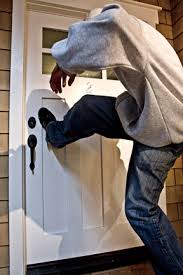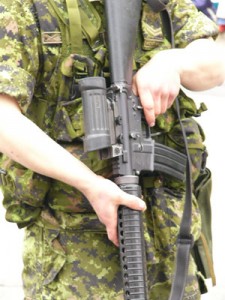Before we dig into our defensive measures let’s take a few moments to assess the threats we might be facing.
Opportunistic Threat
 In this type of attack the thief sees an opportunity and grabs it. This type of attacker generally doesn’t do surveillance of his target or put a lot of thought into the act. They are generally “drive-by” attacks looking for low risk, unoccupied homes. Surprisingly, the majority of these don’t occur in the middle of the night, but in the middle of the day while the owners are at work. Confrontation is the last thing the thief wants because it raises their risk of capture and leaves witnesses. They drive through neighborhoods looking at each house, trying to identify one with the least risk of detection and capture.
In this type of attack the thief sees an opportunity and grabs it. This type of attacker generally doesn’t do surveillance of his target or put a lot of thought into the act. They are generally “drive-by” attacks looking for low risk, unoccupied homes. Surprisingly, the majority of these don’t occur in the middle of the night, but in the middle of the day while the owners are at work. Confrontation is the last thing the thief wants because it raises their risk of capture and leaves witnesses. They drive through neighborhoods looking at each house, trying to identify one with the least risk of detection and capture.
A thief’s objective is to break in quickly, grab as much as they can in 3-4 minutes, and be gone before neighbors can call the police. They’re looking for ease of access, a soft target, low risk, and easy egress of the area. This is by FAR, the most common type of break-in.
Directed Threat
Most people will never be the victim of this type of attack because it requires time, resources and expertise. The objective of this type of attack is very specific; the criminals are after something of great value and are willing conduct surveillance over an extended time to find out how to access it with minimum risk. An example of this would be collections of jewelry, art, or other collectibles. The attacker wants to pinpoint the time and location of these objects and gain access at a time when their risk is lowest. The directed threat is very unusual but could occur if you have extremely valuable items in your home.
Concept of Layers
Try to picture your security as a series of layers, kind of like the layers of an onion. Your door lock is one layer to prevent entry, but no single layer can stop a determined intruder. Let’s just accept that the best any single layer can do is either discourage or delay an intruder. Every layer you implement has a specific purpose. Some simply give passersby a specific impression of your property, while other layers are more proactive. Your layers shouldn’t consist of all physical barriers, but psychological ones as well – with each designed to transmit a specific message.
 The military uses layered defensive positions, complete with a remote Listening or Observation Post (LP/OP), defensive lines, barbed wire, trenches, anti-personnel mines, fields of fire, ground surveillance radar, night vision devices, punji sticks, fire pits, command detonated mines, machine guns, fox holes, etc, etc.
The military uses layered defensive positions, complete with a remote Listening or Observation Post (LP/OP), defensive lines, barbed wire, trenches, anti-personnel mines, fields of fire, ground surveillance radar, night vision devices, punji sticks, fire pits, command detonated mines, machine guns, fox holes, etc, etc.
Unfortunately, most of us have homeowner’s associations that will object to such measures but we can at least adopt the military’s concept: different types of security arranged in concentric layers around our property, all working together. Let’s take a look at some of the layers you could employ:
Operational Security (OPSEC)
The idea of operational security has been around for a long time but few people actually employ the concepts. OPSEC is a way of life that you have to practice every day, with no breaks. It’s kind of like virginity – once you’ve lost it, it’s not recoverable. A single moment of weakness can compromise the entire security system. You’re probably thinking that I’m paranoid, living in seclusion and never talk to my neighbors. Well, the paranoid thing might be right, but my neighbors consider me a pretty normal guy – we talk, help each other out, watch each other’s kids, and even share meals. But they still have no idea which room I sleep in. They don’t know my security measures, layers, or the combination to my safes. Their knowledge of my security efforts is limited to what they observe in the areas where I choose to entertain them.
Let me give you an example of a recent experience. My wife and I were invited to dinner at a new neighbor’s house about a month ago. Before dinner they gave us a “tour” of their home, even including their bedroom’s large walk-in closets. In one closet there was a small, hotel room-type safe on the wall with the door open. Passing by I could see our hostess’ jewelry, some watches, and a Glock 19 sitting on top. In the office the host had several coin books (the fold-out kind with coins inserted into slots) sitting on his desk – almost on display. He proudly explained he was a lifelong coin collector and had recently inherited his father’s extensive collection, even going so far as to pull out a drawer to show me a pile of other coin storage containers inside. He laughingly commented that his inherited collection was worth more than the house we were standing in.
During dinner his kids ran in and out of the front and back doors, not bothering to close or lock them – leaving only the glass outer door closed, but unlocked. I noticed no alarm system, cameras or sensors in the house but did notice a bowl with his wallet, and both their sets of keys sitting just inside the front door. When leaving after dark they had only a small 40-watt light illuminating their front step. Looking back at their house I could clearly see them moving around the well-lit room through the windows.
In that visit these people entrusted me with a tremendous amount of information, even though I was a recent acquaintance. I knew what valuables they possessed, where they were located, what their vulnerabilities were, identified two excellent easy-entry points, and showed me where I could get a handgun, wallet and keys to a new car.
Fortunately for my new neighbors I’m not a thief – and most of us aren’t. However, there ARE thieves out there waiting for someone to point out a target good for them. What if I had passed along a little gossip about the neighbor, making a casual comment about his extensive and very valuable coin collection? Or how he had a “safe full of jewelry and guns” in his bedroom closet? Maybe even throwing in that, while the kids were home, none of the doors were ever locked? One person talks to another person, etc. until the wrong set of ears hear everything. OPSEC.
Another friend used to collect stamps. I say used to because he lost his entire collection in a daytime smash and grab attack. The thieves knew exactly what they were after when they kicked in his back door, bee-lined to his home office and grabbed everything they could find. According to the neighbor that witnessed almost everything, they were in and out in less than five minutes – long before the police could respond to the witnesses’ phone call. How could this happen?
My friend was a friendly guy that attended stamp shows and local collector meetings. He often had other collectors over to his home to do whatever stamp collectors do. He was known to be an active buyer and seller, as well as listing things on the Internet. Finally, he had a small booth at local stamp and coin shows, freely passing out his business cards to attendees in hopes of buying collections. It was common knowledge that he had an extensive and very valuable collection.
Over a year after his break-in the police discovered a small fraction of his collection while executing a search warrant. The suspect admitted to the earlier theft, saying he and his partner had heard about the collection and visited the stamp and coin show where they picked up my friend’s business card. Unfortunately he had put his home address on the card, making the job much easier for the thieves. They drove by the house a few times waiting until there were no cars in the driveway, then entered through the back door because it was out of sight. They ultimately sold his $400K collection for a measly $1,800. OPSEC.
You must understand that it’s critical that you realize that your expertise and job could increase your risk. If you give interviews, write articles, or give talks you must be vigilant about the information you share. If possible, do your best to totally disconnect your personal life from your professional one. Don’t give interviews in your home where potential thieves can see the layout, assess their risk, and make plans. If you DO have valuable collections in your home please understand the OPSEC is doubly important and you need to take extra precautionary measures to protect them and yourself. The only sure way to keep a secret is if only one person knows it. As soon as a second person knows, the world will soon follow.
If you have valuables in your home, protect that secret as if your life depends on it, because it does. Good OPSEC depends on everyone in your home. Children can often be the biggest leaks of sensitive information. In their innocence they think nothing of saying “tomorrow we’re going to the beach for a 2-week vacation”, or “my daddy has lots of guns that he uses for deer hunting”. Instilling OPSEC into children can be a challenge, to say the least.
Now let’s talk about establishing some layers, or zones to protect yourself, your family and your property. We’ll begin with the outer-most “Perimeter Zone” and discuss the different layers you can emplace. From there we’ll move to the layers inside your “Detection Zone”, and finally to everything you can do within the walls of your home, calling it the “Interior Zone”. If you happen to live in an apartment there are some special considerations, so I created the “Apartment Living” section to discuss these.